This cute, little, colorful guy delighted in hanging around our veranda in Kauai, Hawaii, grabbing bites of food we offered to the assortment of winged life that perched in vacation paradise.

Cardinal Yellow-billed male
Cardinal birds are not difficult to attract if you live in Hawaii or South America. They feed on “seeds, fruits, vegetables and insects.” What a diet of variety! They seemed to consume anything I set out when on vacation.
Sugarcane plant stalks are abundant in Hawaii and viewed along the side of roads and in fields. I would often ask myself “are those cornstalks or sugarcane?” Of course, sugarcane was once Hawaii’s bread and butter. These plants of God, allowed the Hawaiians to be sustained. “Around 600 A.D., the first settlers in Hawaiʻi brought to the islands several varieties of sugarcane. The Native Hawaiians cultivated sugarcane, or kō in Hawaiian, and ate it as food and medicine.” Later, in the 1800s, it was primarily shipped to America’s mainland.

The last operating sugar plant in Hawaii, atop photo—“Hawaiian Commercial & Sugar Company.” It closed its doors in December 2016. The second photo is of an old cane transportation truck left at the deteriorating Kauai sugar mill.

You can locate fresh sugarcane in stores in Hawaii and the canes are also sold at farmers’ markets and also sugarcane juice.

Northern Cardinal with art effect
Their name “cardinal” aptly fits, as they are superior in loveliness. The outstanding Northern Cardinal (all red) reminds us of winter fun, festivities and Christmas. Cardinal means “red.”
And the red might remind one of the precious blood Christ spilt on behalf of all men that they might be saved by asking God to cleanse them and be eternally saved by Christ’s blood.
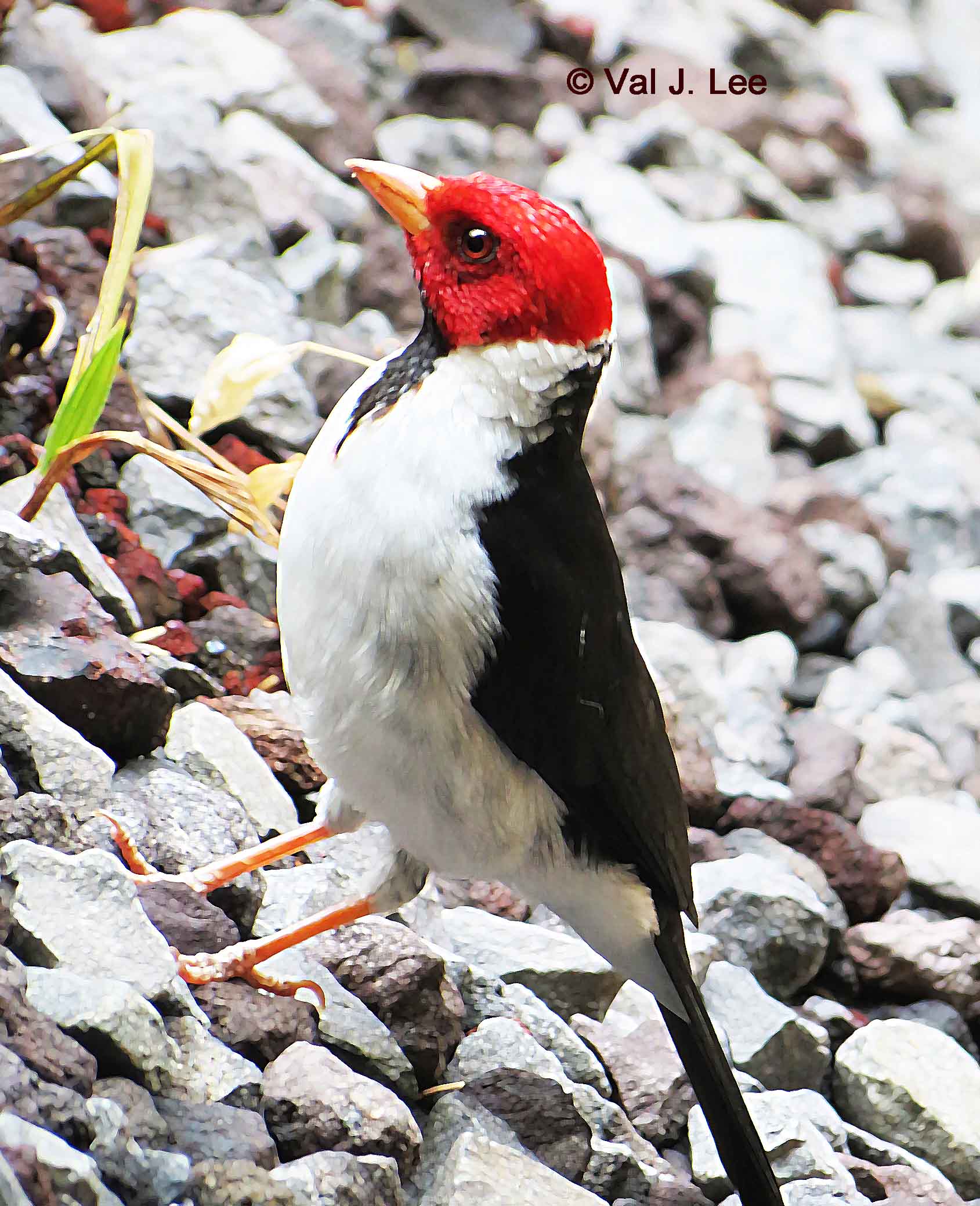
Cardinal-Yellow-Billed
The Red-crested and Yellow-billed Cardinals certainly display beauty in radiant red as well.
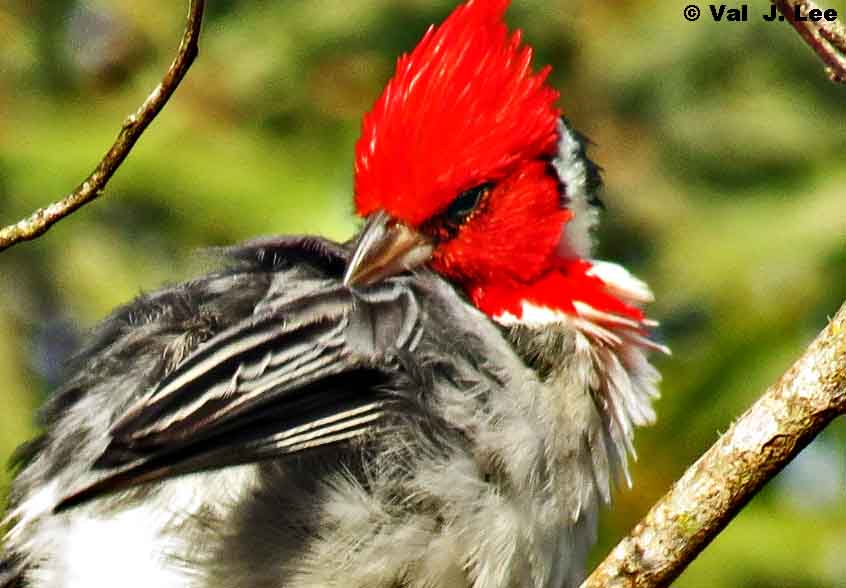
Cardinal red-crested mad
The Red-crested is also categorized as the Brazilian Cardinal. They are native to South America (“northern Argentina, Bolivia, Paraguay, Uruguay, Brazil’s Rio Grande do Sul and southern part of the Pantanal”). And this ave was introduced to exquisite Oahu, Hawaii around 1930 and landed later on the other islands.
From the photos, you will notice the Red-crested (Paroaria coronata) owns a bright red head, crest, and upper chest. They are dark gray above, and the rear neck and underparts are white. Their bill is silver-gray. Females are similar though display an orangish/light brown head and crest and upper chest.

All three cardinal species are mid-sized songbirds with a body length of 8.3–9.3 inches, and a wingspan of 9.8 to 12.2 inches. The adult weighs in at 1.19 to 2.29 ounces. Males are slightly larger than females.
All are very romantic and are monogamous (mating for life) Where would we be today if God had not created both male and female?
As with many birds, affection involves the male feeding the love of his life and serenading her. Following the cardinal romancing period, the female will lay 2-5 eggs, being buff-white with dark marks, which she incubates for 12-13 days.
The male keeps a close eye on his mate and the surrounding territory for predators. He dutifully feeds her on the nest. Once the fledglings hatch, revealing their cute brown heads, the doting parents engage in the feeding process. The male is not simply a spectator, he works in every way to provide for his family.
The cardinals will attempt two broods each season.
Jesus Christ manufactured birds to lay a certain number of eggs, often superseding two, so species are not readily eliminated. God’s reproduction science is a calculated, involved process for all kinds.
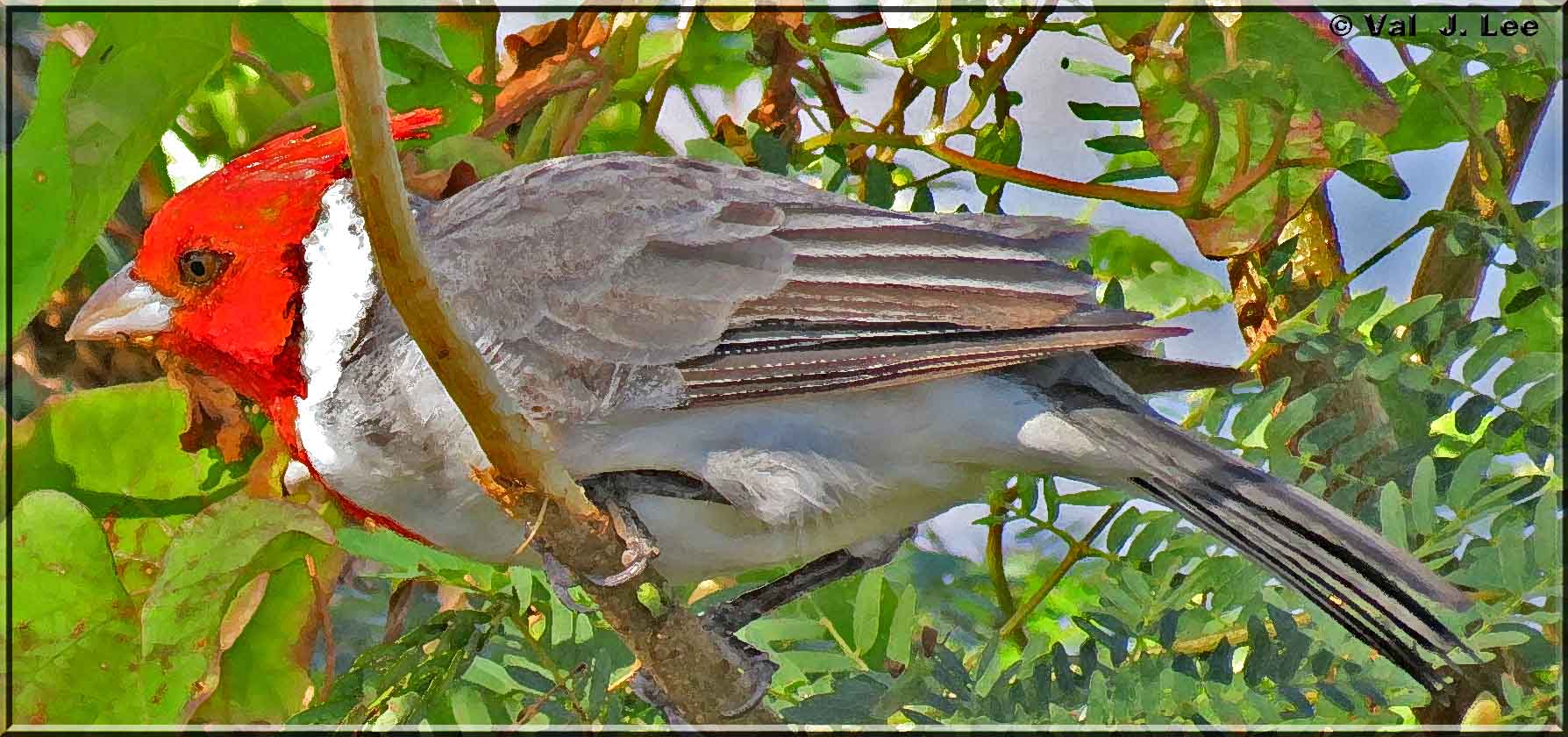
Cardinal red-crested male
God allows them three to six years on the earth.
The Yellow-billed (Paroaria capitata) was the latest of inductees, introduced to Hawaii in the 1960s.
It’s native to “Brazil, Paraguay, Bolivia, Uruguay, and northern Argentina.”
What makes this cardinal most unusual, is it has no crest (no lovely puffy head adornment or red bouffant).
This photogenic ave exposes that vibrant red head, far deeper red than you would notice on any red-headed person’s head. Followed by a lovely white neck collar and a white chest and gray/black back.
Yellow-billed Cardinal moms usually lay “three white eggs with brown streaks in a deep cup-shaped nest in trees or close to the ground in shrubbery.” Incubation period is 13 to 14 days and performed by the mother. Chicks fledge or fly within 10 to 12 days of hatching. Immature Yellow-billed Cardinal males reveal brown heads instead of red.
They, like other cardinals, live three to six years.
We all adore the fact, adult males, Northern Cardinals (Cardinalis cardinalis) are dressed in bright red, appearing royal. A male wears a black face mask over his eyes, extending to his upper chest. The color becomes duller and darker on the back and wings. He does display a red beak to match his manly, bright costume.
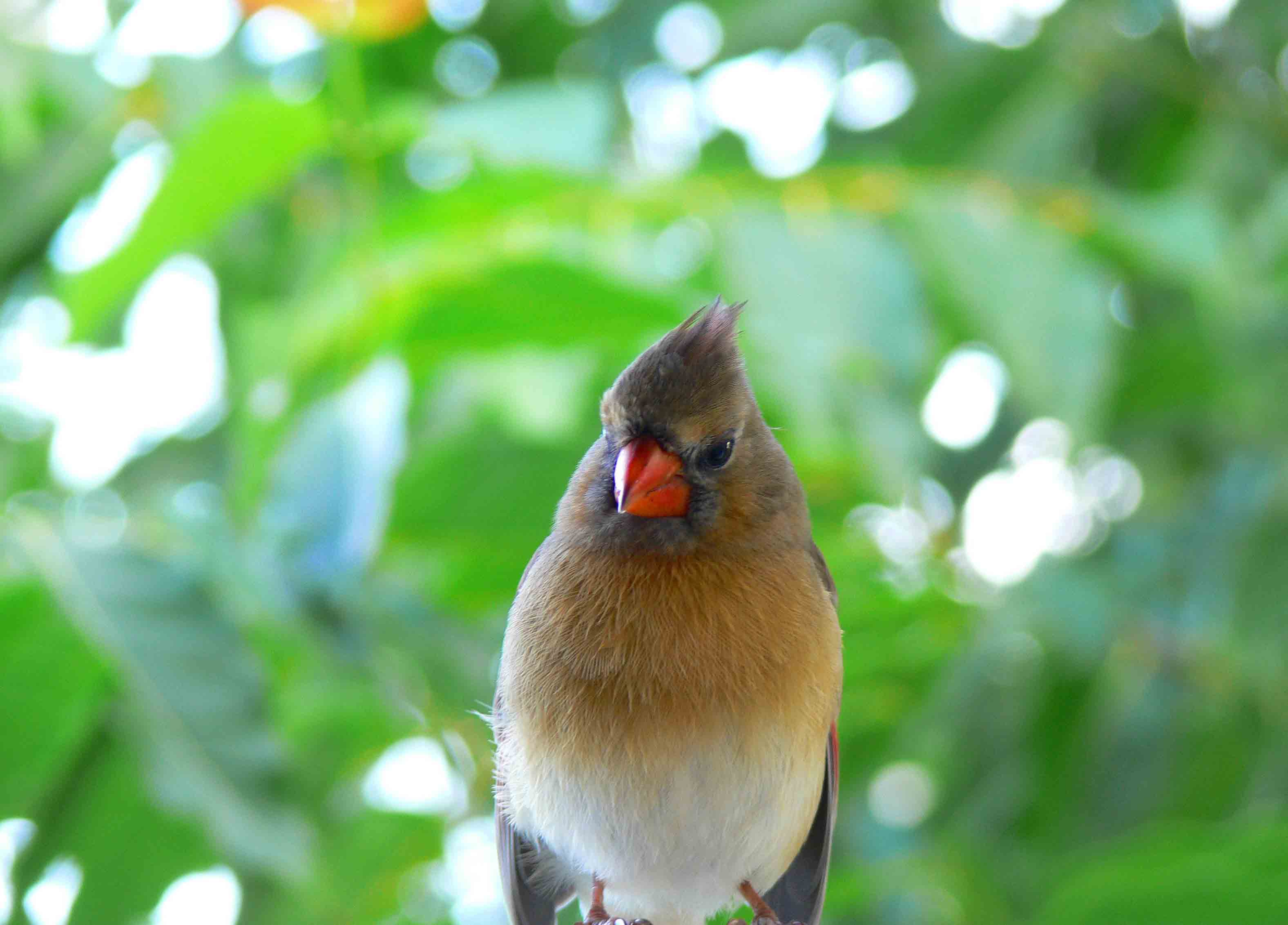
Northern Cardinal female
Females mostly display a fawn coloration, with a reddish tint on the wings, crest, and tail feathers. The lovely face of the female is gray to black, with some tawny brown. And she displays a distinct red/orange beak, resembling bright red lipstick.
Both sexes possess that prominent raised crest that sets apart this bird. The beak is cone-shaped and strong for its designed tasks.
Their crest may reveal their mood, if lowered, they are relaxed; and if uplifted, it may express the fact they are agitated, though they seem to enjoy singing with their crest elevated and it certainly adds to their pizazz.
In early spring males will aggressively claim territories for their planned families.
Males do select a gal for life so it is an important decision. And a gal can reject a suitor. Northern couples enjoy singing repertoires together throughout their lives; yes, and past the breeding season. Additionally, the male cardinal is always willing to forfeit his existence to protect his life love and their offspring.
The mother-to-be will build a shallow-cupped nest with a bit of assistance from the father-to-be. The female will weave differing materials together of bark, grasses, twigs, leaves, etc. She will line it with animal furs or other soft materials. We have one bunny, Sweet Thing, running around our yard and our neighbor has three rabbits. They go under the fence to visit each other. I believe their scattered fur on the grass is often used for bird nests due to its disappearance. Sweet Thing, is an indoor-outdoor bunny and loves being in the front yard where he receives lots of attention from passers-by. Here is a link to my cost-free ebook about him and his bunny friends, As Cute as a Bunny—Sweet Thing’s True Stories—https://wp.me/piRgw-1Mz
Sweet Thing video:
They fledge or fly at 10 to 11 days of age.
Juvenile cardinals, both sexes, reveal coloring similar to the adult female with fawn coloration—reddish-brown on lower body and forehead, wings and tail. During the autumn season, they molt (lose their present feathers), developing their adult feathers.
God crafted them to endure the winter months in wintery states by fluffing their down feathers which trap the warm air set next to their body. And they will maintain body heat for their legs by taking turns tucking one leg at a time within their body area.
Both the male and female will sing clear, whistled song patterns, being repeated several times, then their repertoire is varied as we note when we listen to the myriad of songbirds. They may sing a sharp “chip-chip-chip or a long cheer-cheer.”
The Northern Cardinal is the state bird of seven American states—more than any other ave—“Illinois, Indiana, Kentucky, North Carolina, Ohio, Virginia, and West Virginia.”
One of the most interesting facts about Northern Cardinals is they practice what is appropriately called anting. In actuality, over 200 species of birds, mainly songbirds, cover themselves in ants. Ornithologists suspect ants release “formic acids,” assisting birds to repel lice. “The cardinal will hold an ant in its beak, spread and lower its wings, and brings its tail forward between its legs, wiping the outer wing and tail feathers with the ant.” There is a youtube video whereby you can observe the process.
Regarding not being too fearful of humans, there is a video of a Northern Cardinal that came to perch on a man’s finger and didn’t want to leave him. And they will eat from a stranger’s hand if the person is fairly still. They also have been known to sit on people’s shoulders, etc; not wanting to fly away, right away, that is.
Holding great loveliness and song, the Northern Cardinal was once prized as a pet all across America up till 1918. Since then it has been illegal to sell as a caged bird.
In extremely rare circumstances, God dresses this bird in a yellow motif. One yellow cardinal is spotted a year in our country.
The lifespan of the Northern Cardinal is three to five years as with all other cardinal birds, though a few have lived far longer. “The longevity record for a captive Northern Cardinal is 28 ½ years.”
There is also a Vermilion Cardinal which looks almost identical to the Northern though it displays a taller crest or spiked hair 😊, and might display a brighter or duller plumage in instances. Their crest reminds me of a cockatoo parrot.
They inhabit the northern coastline of South America.
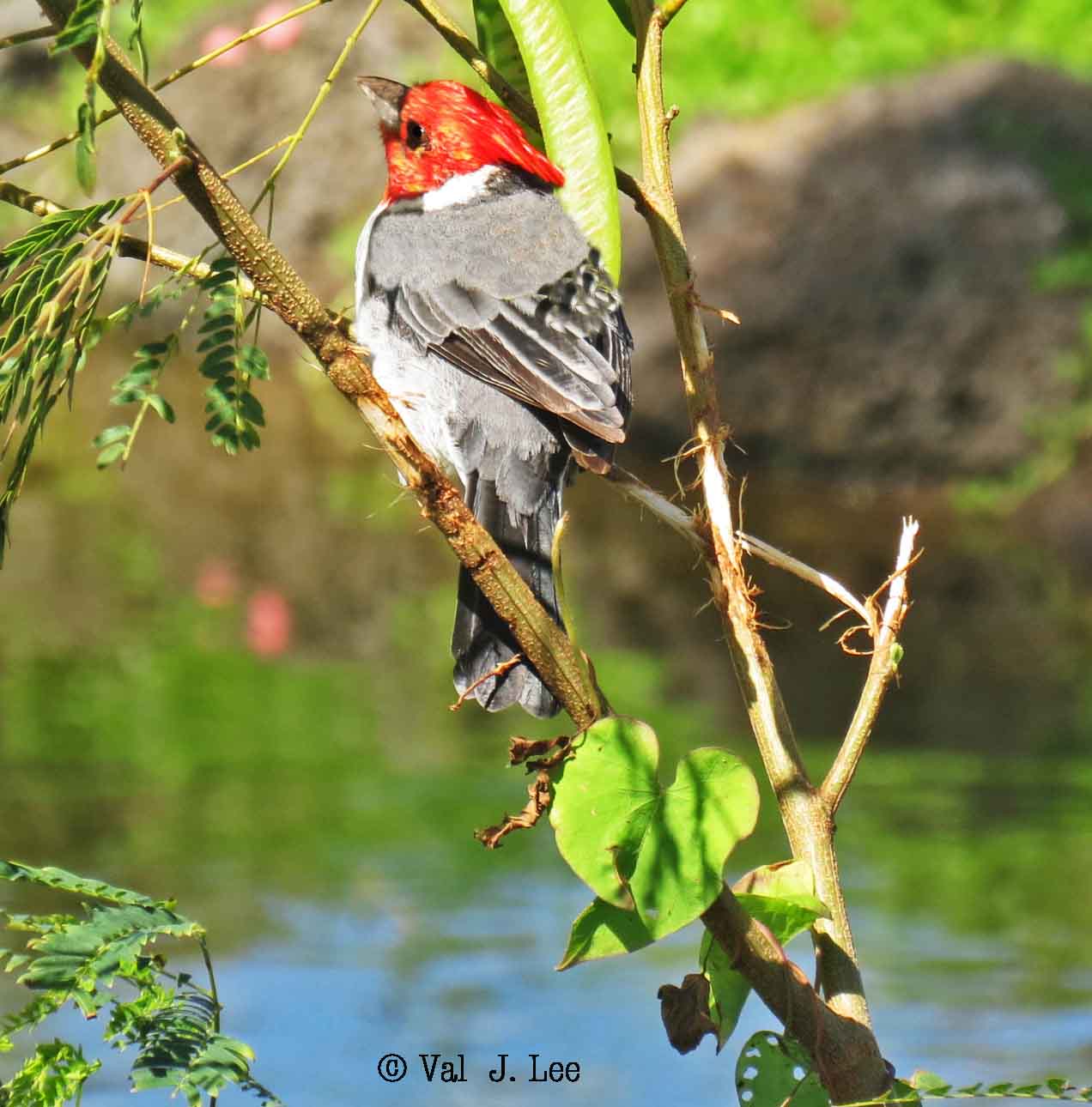
cardinal red-crested male
All Cardinal birds are found near watery areas and will visit bird feeders. Cardinals visit “forested marshes, flooded fields, riparian scrub and forest, and wooded lakeshores.” They can be spotted by towns and cities where water is abundant, including towns situated by a river or lake.
Cardinals do not appear to be disturbed by the human presence if a little distance is maintained.
They are preyed upon by larger sky and ground predators.
Cardinal aves do not migrate and of course, what bird would want to wander from Hawaii?
Love to all, Val (All photos by © Val Lee)
Letter to the Bird Enthusiast—https://birdsbyval.wordpress.com/2012/03/03/letter-to-bird-enthusiast/
